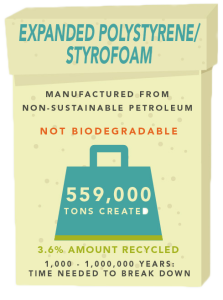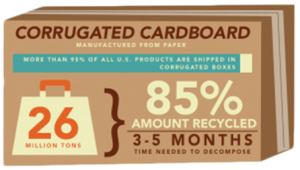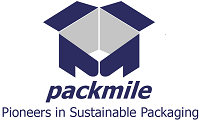Void filler—we’re not really fans of it. But we recognize that even the most sustainable packaging systems need at least a little bit of it. Sometimes we ship oddly-shaped objects that won’t fit in a rectangular box. Sometimes we put multiple items in a box, inevitably leaving some empty space. Regardless, the goal should always be to use the smallest amount possible.
So how can you do that? From a sustainability standpoint, what void fillers will leave the smallest impact on the environment? Let’s compare.
1) STYROFOAM
Styrofoam is made from expanded polystyrene and is commonly used in packing peanuts or in blocks to hold fragile items in place (such as electronics or wood furniture). I’ve searched all over the internet to get a good estimate for how long it takes for polystyrene to decompose and have never been able to get a good consensus. Some sources say as little as few decades, while others say it will literally never decompose. What we do know is that this material is not biodegradable and is rarely recycled. Polystyrene also creates 7.6 pounds of CO2 for every pound produced.

2) POLYETHYLENE
Polyethylene is the type of plastic used to make most plastic bags and two of the most common types of void filler: bubble wrap and air pillows. This material is generally believed to decompose faster than styrofoam and is much more easily recycled. 6.1 pounds of CO2 are created for every pound of polyethylene produced. It is important to note that this void filler is filled with air, so not of lot of weight needs to be added to a box in order to fill it.

3) PAPER PRODUCTS
We’ve become extremely efficient at creating corrugated or other paper products. It only takes 1.04 pounds of CO2 to produce one pound of corrugated. Also, this is by far the most easily recycled material of the bunch and it decomposes far faster than any of the other void fillers. However, it is a little heavier than other materials.

SO WHO COMES OUT ON TOP?
Let’s recap CO2 creation per pound of void fill:
- Polystyrene—7.6 lbs. of CO2
- Polyethylene—6.1 lbs. of CO2
- Paper products–1.04 lbs. of CO2
When comparing these void fillers with each other, it’s important to consider not just the amount of CO2 created per pound, but also how much space that pound of void filler will take up. In other words: air pillows may require a lot of CO2 per pound, but they’re so light that one pound of air pillows could fill 20 cubic feet of boxes.
Here’s how much weight is required to fill one cubic foot for each of the void fillers:
- Packing Peanuts (polystyrene)—0.2 lbs.
- Bubble Wrap (polyethylene)—0.2 lbs.
- Air Pillows (polyethylene)—0.05 lbs.
- Paper products—0.25 lbs.
With these two sets of numbers, we can calculate the carbon footprint of each void filler per cubic foot:
To be clear: if you were to fill a 12 x 12 x 12″ box with void filler, this is the amount of CO2 that would be created by producing the materials in that box. It doesn’t take into account the recycle rate or decomposition time of any of the materials.
Some may ask whether the extra weight of the void filler adds to the carbon footprint of transporting your packages. The answer is no. When a 53′ semi truck already weighs over 30,000 pounds, the effect of adding a few pounds in heavier void fill is negligible.

Paper has the lowest carbon footprint, the highest recycle rate, and the quickest decomposition time, it seems obvious that it’s the most sustainable of the void fillers.
Comments are closed.


Recent Comments